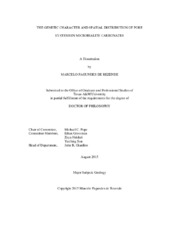| dc.description.abstract | Microbialite carbonate deposits are highly influenced by environmental settings, resulting in a large variety of depositional textures and fabrics. Pore systems in these deposits have a primary relation to the dominant depositional texture, which is later modified by diagenesis. Therefore, recognizing the textural controls on the pore system development and petrophysical characteristics is important to enhance the reservoir quality prediction in subsurface. Three microbialite carbonate deposits on different basins and ages were studied to address the effectiveness of these controls.
The first deposit, documented in chapter I, is a microbialite build-up formed in the Holocene lagoon Lagoa Salgada in Brazil. This deposit has undergone minimum diagenetic evolution, and textures and pore systems are directly correlated. Their textures and pore systems were evaluated by computed tomography and petrography. Stratigraphic interpretation and carbon and oxygen stable isotopes link these changes to depositional settings. The results show that large structure size, open packing and chaotic fabric form a better primary pore system.
The second deposit is the subsalt microbialite carbonates formed in lacustrine to lagoonal settings in the Santos Basin, Brazil. These carbonates have high heterogeneity in terms of textures and pore systems. Texture analysis indicated that particle size is a primary control on pore size and permeability, whereas sorting influences the porosity, and the permeability, and packing is a secondary control on porosity. Cements reduce the final pore system, while dissolution enhances it. These results are presented in chapter II, and supplemented with log interpretation in Appendix A.
The third deposit, documented in chapter III, is an outcrop with lacustrine microbialite carbonates of the Eocene Green River Formation in Utah. Computed tomography and petrography were used to characterize pore systems and their relations to textures. In these deposits, pore systems derived from chaotic and open fabrics are better developed, with larger pores and higher connectivity than those derived from organized and tight fabrics. Stratigraphic relations indicate a strong depositional control on the distribution of microbialite textures throughout the outcrop. | en |


